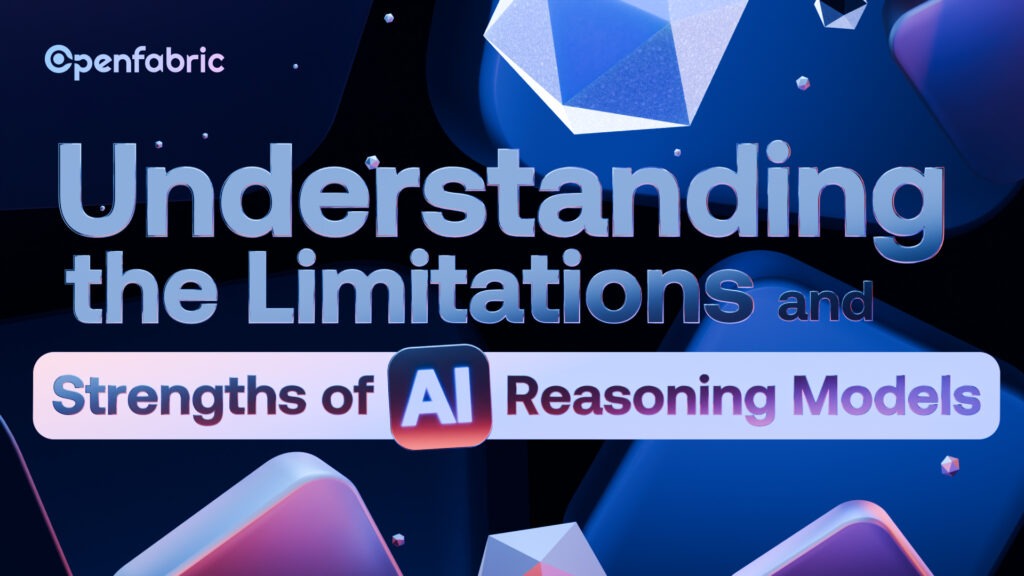
June 13, 2025 6 minutes read
Understanding the Limitations and Strengths of AI Reasoning Models

For a while now, artificial intelligence has been on a journey to conquer and master complex reasoning, especially human-like reasoning. With this goal in mind, there have been several attempts at making AI reason and provide results with near-human precision. All these attempts led to the development of AI reasoning models in the 20th century. In the 21st century, these models have found very wide applications in areas that were once deemed impractical. Despite the wide range of applications of AI reasoning models, they may still be underutilized especially when the end users do not understand the limitations and strengths of AI reasoning models.
Thanks to the advancement of technology, the concept of AI reasoning models is not just one of pen and paper. It is real and there are real-life uses of these models that are solving basic human problems every day in homes and even large organizations. Some AI reasoning models have gone as far as being interwoven with the fabric of our day-to-day lives. We see them being used and we use them every day. That is why it is important to understand what it can and cannot do. We must know the limitations and strengths of AI reasoning models to achieve more satisfaction in their use. Knowing these strengths and limitations also helps in the advancement of this technology in solving our problems, and generally, making life better and easier.
In this article, we will discuss all there is to know about the limitations and strengths of AI reasoning models.
Let’s get started!
What are AI reasoning models?
Let us assume that all these while the one question on your mind is, “What exactly are AI reasoning models?” Learning what AI reasoning models are is quite important to get the whole picture when we talk about their limitations and strengths. Before we get all technical with it, AI reasoning models are simply AI models that can reason before giving you a response to your query. They are not just limited to generative AI models alone, but a generative AI model that can reason is also considered an AI reasoning model.
When we dive deep we begin to see that AI reasoning models are not just any type of AI models. They are, in fact, large language models (LLMs) that can process information like the human brain. Other texts also call them ‘thinking models’ because like you they have an intricate nature of processing information similar to how the human brain processes information. However, in terms of speed, these models are nowhere near the speed of the human brain as a typical reasoning query may take as long as three minutes to generate a response.
For AI reasoning models to function effectively, they must first be trained on a vast data set known as hyperparameters. These hyperparameters serve as a hub of information that the model uses. In addition to human-like reasoning, these models can learn, adapt, and evolve beyond the hyperparameters they were trained with.
There are different types of AI reasoning models. Each model has a unique application or purpose for which it was designed. Even for these purposes, these models still have boundaries or limitations we must recognize while using them.
What are the limitations of AI reasoning models?
Lack of understanding
In some cases, AI reasoning models may not be able to understand the full context of the query. As such they provide well-thought-out results, but these results may not align with what the user wants. This has left a trail of unsatisfied users after some attempts at generating the right responses for their queries have failed.
However, most such encounters may be experienced by vague prompts or prompts that are not comprehensive enough to provide enough context to provide the right response. An event like this can be managed better with the AI Prompt Engineering feature from Openfabric. With Prompt Engineering, you as an end user can go and find prompts that are more suitable for the query. These prompts all have their results available. That way you can see the end product before you make a selection. Read more about Openfabric’s AI Prompt Engineering HERE.
Cost of acquiring data
Reasoning models work with highly accurate training data. To get data that is that accurate, it must be gotten from numerous sources, and require a lot of human and physical resources. The cost of acquiring data accurately makes people question if it is even worth it in the end.
AI reasoning models work more efficiently by generating a chain-of-thought (CoF) and incorporating self-verification. This has been shown to improve the model’s performance. However, high-quality data and scalable CoT data are scarce, and scarcity makes the cost of this data expensive.
The “Overthinking Phenomenon”
The overthinking phenomenon is a little similar to the very first limitation of AI reasoning models. Here, however, the AI models generate verbose and redundant outputs even after finding the solution or answers to the query. This phenomenon is seen in many AI reasoning models. By “overthinking” they often ignore or misinterpret external feedback even when a simpler result is available. The effect of this is an increased computational cost, inefficiencies in the workflow, and errors that may have serious consequences.
By pointing out and understanding these limitations, we can recognize them when they come and resolve them or find alternatives as quickly as possible to ensure the smooth running of our day-to-day lives.
What then are the strengths of AI reasoning models?
Both industrial and personal applications of AI reasoning models have benefitted from the various capabilities and added advantages it brings to a person’s daily life and the workflow in a workplace.
- Reasoning models use CoT which shows the steps to get its answer. This ability is particularly useful for tasks that require logic or multi-step thinking.
- They are designed to handle complex problem-solving in subjects like math and sciences. In a world ruled by science, they come in handy at any level of scientific involvement.
- AI reasoning models alone have helped in advancing the adoption of AI. By slowing down and intricately processing information, they provide information that is highly accurate and that users can trust.
- The accuracy of AI reasoning models is valuable in industries where accuracy is highly valued such as health care and finance.
Conclusion
Most of the tasks that AI reasoning models do are complex and would take hours, days, or even weeks without the help of these reasoning models. AI reasoning models trade-off accuracy with speed but processing complex tasks in minutes cannot be compared with doing similar tasks in a much longer time. When comparing the strengths and limitations of AI reasoning models, it may seem like there are a significant amount of limitations. However, we must understand that these limitations do not hinder the use of these models.
As AI development progresses daily, we expect to see more improvements in AI reasoning models.
For more information and insights, visit our WEBSITE today!

